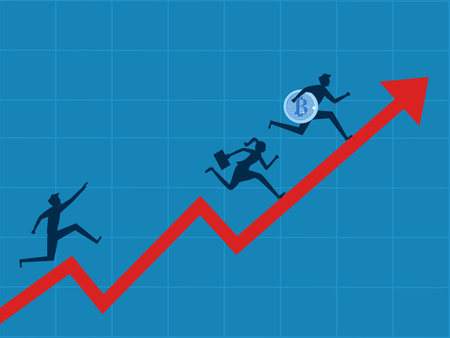1. Introduction to Active and Passive Investing
In the United States, the debate between active and passive investing strategies has become a central theme in portfolio management and personal finance discussions. Each approach represents a distinct philosophy toward achieving long-term financial goals, managing risk, and optimizing returns. Active investing involves frequent trading decisions, often relying on market analysis, economic forecasts, and the expertise of portfolio managers to outperform benchmarks such as the S&P 500. In contrast, passive investing typically seeks to replicate the performance of a broad market index through instruments like index funds or ETFs, emphasizing low costs and minimal trading activity.
The motivations behind these two investment styles reflect differing attitudes towards market efficiency and risk tolerance. Active investors believe that skilled analysis can uncover undervalued securities or market trends, offering the potential for higher returns despite increased volatility. Passive investors generally adhere to the efficient market hypothesis, which suggests that all available information is already reflected in asset prices, making it difficult to consistently beat the market after fees. As U.S. investors increasingly focus on long-term wealth accumulation—whether for retirement accounts like 401(k)s or taxable brokerage portfolios—understanding the fundamental differences between these approaches is essential for aligning investment strategy with individual financial objectives.
2. Understanding Volatility and Risk Measurement
When comparing active and passive investment strategies, understanding how to measure and interpret risk is crucial for American investors. Volatility, often seen as the fluctuation in asset prices over time, serves as a key indicator of risk. But volatility alone does not provide a complete picture—investors commonly rely on several quantitative metrics to assess risk and potential returns in their portfolios.
Key Risk Metrics Defined
| Metric | Definition | Why It Matters |
|---|---|---|
| Standard Deviation | A statistical measure indicating how much returns deviate from the average return over a period. | Higher standard deviation means greater volatility; helps investors gauge the consistency of returns. |
| Beta | A measure of an investment’s sensitivity to market movements (S&P 500 = 1). | Beta above 1 signals higher volatility than the market; below 1 means less volatility. Useful for benchmarking risk exposure. |
| Sharpe Ratio | A risk-adjusted return metric calculated by dividing excess return by standard deviation. | Higher Sharpe ratio indicates better compensation for taking on additional risk. Essential for comparing funds or strategies. |
The Importance of Volatility Assessment in the U.S. Market
American investors face unique market dynamics, from Federal Reserve policy changes to global economic influences. Assessing volatility through these metrics allows investors to align their portfolios with their individual risk tolerance, financial goals, and investment horizons. For example, retirees may prefer lower-volatility, passive index funds, while younger investors might accept higher beta or standard deviation in pursuit of alpha through active management.
Why Risk Metrics Matter for Long-Term Planning
Effective long-term portfolio construction relies on balancing risk and reward—choosing between active funds that seek alpha (and potentially higher volatility) versus passive vehicles with more predictable beta exposure. By monitoring standard deviation, beta, and Sharpe ratio, American investors can make informed decisions, manage expectations during market swings, and work towards sustainable wealth accumulation over decades.

3. Historical Volatility: Data Analysis of Active vs. Passive Funds
When evaluating the risk and return profile of investment strategies, it’s crucial to compare historical volatility between active and passive funds. Over the past two decades, empirical data from sources such as Morningstar and S&P Dow Jones Indices consistently reveal that passive index funds, like those tracking the S&P 500 or Total Market indices, generally exhibit lower volatility compared to actively managed mutual funds and ETFs. For instance, during the period from 2003 to 2023, the standard deviation—a common measure of volatility—of major U.S. equity index funds hovered around 14% to 16%, while comparable active funds often registered annualized volatilities closer to 18% or higher.
Comparative Performance Metrics
Looking at returns in tandem with risk, long-term data demonstrates that while some active managers outperform their benchmarks in certain years, few maintain consistent outperformance after fees over a full market cycle. According to the SPIVA (S&P Indices Versus Active) U.S. Scorecard, more than 80% of large-cap active funds underperformed their benchmark indices over ten-year periods ending in 2023. Furthermore, these same funds tended to display greater dispersion in returns, reflecting increased volatility and less predictability for investors focused on long-term wealth accumulation.
Consistency in Volatility Profiles
The advantage of passive investing becomes especially apparent when considering rolling volatility—analyzing how risk levels shift over time. Passive index funds show remarkably stable risk characteristics across both bull and bear markets. In contrast, active fund volatility can spike due to concentrated bets or tactical asset allocation shifts that don’t always pay off. This consistency makes passive strategies attractive for investors seeking to minimize downside surprises and maintain a predictable risk exposure in their portfolios.
Empirical Evidence from Major Funds
Case studies of flagship funds reinforce these trends. For example, the Vanguard 500 Index Fund (VFIAX) reported a trailing ten-year standard deviation of roughly 14.5%, aligning closely with its benchmark index. Meanwhile, top-performing active large-cap funds exhibited not only higher average volatility but also wider performance swings year-to-year, making them less reliable for disciplined, long-term investors aiming for steady portfolio growth.
4. Risk-Adjusted Returns: Evaluating Performance
When comparing active and passive investment strategies in the U.S. market, risk-adjusted returns offer a deeper lens for performance evaluation beyond raw returns. The most widely used metrics for this analysis include the Sharpe Ratio, Sortino Ratio, and Alpha. These tools help investors determine whether a strategy’s higher returns are truly worth the additional risk taken.
Understanding Risk-Adjusted Returns
Risk-adjusted returns measure how much excess return an investment generates for each unit of risk assumed. For example, the Sharpe Ratio is calculated by subtracting the risk-free rate (often U.S. Treasuries) from the portfolio’s return and dividing by its standard deviation. A higher Sharpe Ratio indicates better compensation for risk.
Comparing Active vs. Passive Strategies: Recent U.S. Market Data
| Strategy Type | S&P 500 Index Fund (Passive) | Large-Cap Active Mutual Fund Average |
|---|---|---|
| 5-Year Annualized Return (2023) | 11.2% | 9.0% |
| 5-Year Standard Deviation | 17.8% | 19.1% |
| Sharpe Ratio | 0.58 | 0.47 |
| Sortino Ratio | 0.83 | 0.65 |
| Alpha (vs Benchmark) | 0.00% | -1.30% |
The table above illustrates that while some active managers may outperform in select periods, passive index funds like those tracking the S&P 500 generally offer higher risk-adjusted returns over longer horizons due to lower costs and consistent exposure to broad market trends.
The Importance of Consistency and Downside Protection
A critical factor when selecting an investment approach is consistency of outperformance and protection against severe losses (“downside protection”). Passive strategies typically provide more predictable results aligned with overall market movements, which is especially important during volatile or bear markets. In contrast, active managers must not only beat their benchmarks but do so consistently after accounting for fees and taxes—something few achieve over long periods according to SPIVA U.S. Scorecard data.
Downside protection can be measured using the Sortino Ratio, which focuses solely on harmful volatility rather than total volatility. As shown in the table, passive funds often score higher here as well, since broad diversification mitigates sector- or stock-specific downturns that may catch active managers off guard.
Ultimately, U.S.-based investors should prioritize strategies with a proven track record of strong risk-adjusted returns and reliable downside management—key elements for achieving long-term financial goals without undue turbulence.
5. Behavioral Factors and Real-World Investor Experience
Understanding the Impact of Human Psychology on Investment Decisions
In the context of risk and return, behavioral biases play a critical role in shaping how U.S. investors choose between active and passive investment strategies, particularly during periods of heightened market volatility. While both approaches have their merits, real-world outcomes are often determined not just by data, but by how investors react under stress or uncertainty.
Common Behavioral Biases Among U.S. Investors
1. Overconfidence Bias: Many American investors believe they can outperform the market through superior stock-picking or timing, fueling a preference for active management. However, research consistently shows that over long periods, very few active managers outperform their passive counterparts after fees and taxes.
2. Loss Aversion: The pain of losses tends to be felt more acutely than the pleasure of gains. This leads some investors to switch from passive to active strategies (or vice versa) at precisely the wrong times, such as selling index funds during downturns or chasing star managers after strong runs.
3. Herding Behavior: In volatile environments, there is a tendency for individuals to follow the crowd—moving en masse into popular ETFs or hot mutual funds without independent analysis. This can amplify volatility and sometimes lead to bubbles or sharp corrections.
Real-World Outcomes: Lessons from Volatile Markets
The last two decades in U.S. markets have provided clear examples of these biases at work. During the 2008 financial crisis and the rapid COVID-19 selloff in early 2020, many retail investors panicked and exited passive index funds at market bottoms, only to miss out on subsequent recoveries. Meanwhile, others rotated aggressively between active managers based on recent performance—a strategy known as “performance chasing”—which often resulted in subpar returns due to high turnover and transaction costs.
Behavioral Coaching and Long-Term Success
The key lesson is that understanding one’s own behavioral tendencies can be as important as selecting the right investment vehicle. Financial advisors in the U.S. increasingly emphasize behavioral coaching—helping clients stick with disciplined strategies through cycles of fear and greed—to improve long-term outcomes whether using active or passive products.
Ultimately, while volatility creates both risks and opportunities, successful investors tend to be those who acknowledge psychological pitfalls and maintain a consistent approach tailored to their risk tolerance and long-term goals.
6. Long-term Portfolio Construction and Allocation
For U.S. investors aiming to achieve an optimal balance between risk and return over the long haul, constructing and allocating a portfolio is both an art and a science. The core principle is diversification—spreading investments across asset classes such as equities, fixed income, real estate, and alternatives—to mitigate volatility and capture growth opportunities.
Integrated Approaches to Portfolio Building
Successful long-term investing requires an integrated approach that considers not only asset allocation but also investment style (active versus passive), time horizon, and individual risk tolerance. For example, blending actively managed funds with passive index funds can allow investors to seek alpha in inefficient markets while maintaining cost-effective exposure to broad market movements in efficient sectors. This hybrid strategy helps minimize the downside risks associated with pure active management while still providing opportunities for outperformance.
The Role of Diversification
Diversification is particularly crucial when comparing volatility between active and passive strategies. By allocating capital among different sectors, geographies, and investment vehicles, investors reduce the impact of any single asset’s poor performance on the overall portfolio. Historically, diversified portfolios have demonstrated lower volatility compared to concentrated bets, especially during periods of heightened market uncertainty in the U.S.
Best Practices for U.S. Investors
To build resilient portfolios that withstand market cycles, U.S. investors should routinely rebalance their holdings to maintain target allocations, review performance against benchmarks, and adjust for major life events or shifting financial goals. Leveraging tax-advantaged accounts like IRAs or 401(k)s can further enhance after-tax returns. Ultimately, a disciplined approach grounded in data-driven analysis, strategic rebalancing, and thoughtful integration of both active and passive strategies positions investors to navigate risk and capitalize on long-term growth potential.
7. Conclusion: Making the Right Choice for Your Financial Goals
In summary, our analysis of risk and return in active versus passive investment strategies reveals crucial insights that can guide American investors toward smarter decisions. Active investing offers the potential for higher returns, but it comes with increased volatility and typically higher fees. Passive investing, on the other hand, delivers broad market exposure, lower costs, and generally lower volatility, making it a strong fit for those seeking stability and long-term growth.
Key Findings
- Volatility: Active strategies tend to exhibit greater price swings due to frequent trading and concentrated bets, while passive strategies offer more predictable performance tied to market benchmarks.
- Returns: Although some active managers outperform in certain periods, most struggle to consistently beat their benchmarks after accounting for fees and taxes. Passive funds often match market returns at a much lower cost.
- Costs: Expense ratios and transaction costs are significantly higher in actively managed funds, which can erode long-term returns—especially when compounded over decades.
Actionable Recommendations
If You Have a Low Risk Tolerance or Long Investment Horizon
Consider a predominantly passive approach using index funds or ETFs. This aligns well with retirement accounts (such as 401(k)s or IRAs) where capital preservation and steady growth are paramount. Dollar-cost averaging into diversified index funds can help manage market volatility over time.
If You Have a High Risk Tolerance or Short-Term Goals
You may allocate a portion of your portfolio to actively managed funds or individual stocks in pursuit of alpha. However, ensure this exposure does not exceed what you can afford to lose, and regularly review performance against relevant benchmarks. Remember that timing the market is difficult—even for professionals.
Hybrid Approaches for Flexibility
A blended strategy combining both active and passive elements can offer diversification benefits. For example, use passive investments as a core holding while selectively adding active funds targeting specific sectors or themes where managers have demonstrated expertise.
The American Perspective
The U.S. financial landscape offers an array of products tailored to different investor profiles. Take advantage of low-cost index funds from providers like Vanguard or Fidelity, but also be mindful of unique opportunities—such as sector ETFs or tax-advantaged municipal bonds—that can enhance your portfolio according to your needs.
Ultimately, the right choice depends on your personal risk tolerance, investment timeline, and willingness to stay engaged with your portfolio. By understanding the trade-offs between risk and return in both active and passive strategies, you can build a resilient investment plan tailored to your financial goals as an American investor.


